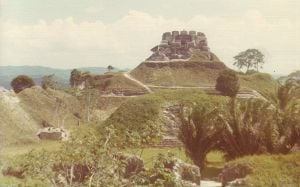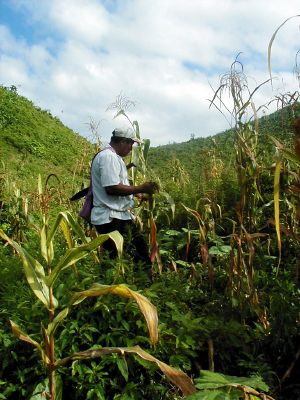Belize
Template:Belize infobox
Belize is a small nation on the eastern coast of Central America, on the Caribbean Sea bordered by Mexico to the northwest and Guatemala to the west and south. The country is a parliamentary democracy and constitutional monarchy which recognizes Queen Elizabeth II as Sovereign. The nation of Honduras is a near neighbour, 75 km away (47 miles) across the Gulf of Honduras to the east. The name is derived from the Belize River which Belize City, the former capital and largest city, is also named after. In Spanish it is usually called Belice. Belize was a British colony for more than a century, known as British Honduras, until 1973. It became an independent nation in 1981. Belize is a member of Caribbean Community (CARICOM) and the Sistema de Integracion Centro Americana (SICA) and considers itself to be both Caribbean, and Central American.
Geography
Belize is located between the Hondo and Sarstoon Rivers, with the Belize River flowing down in the centre of the country. The north of Belize consists mostly of flat, swampy coastal plains, in places heavily forested. The south contains the low mountain range of the Maya Mountains, whose Victoria Peak is the highest point in Belize at 1,160 m. All along the Caribbean coast are found coral reefs or cays. Belize is home to the longest barrier reef in the western hemisphere and the second longest in the world after the Great Barrier Reef.
The climate is tropical and generally very hot and humid. The rainy season lasts from May to November and hurricanes and floods are frequent natural hazards.
History
The Maya civilization spread over Belize between 1500 B.C.E. and AD 300 and flourished until about AD 900.
The first Europeans arrived in the area in the early 16th century and settlement began with British privateers and shipwrecked English seamen as early as 1638.
The origin of the name Belize is unclear but one explanation is that it derives from the Spanish pronunciation of Wallace, the name of the pirate who created the first settlement in Belize in 1638. Another possibility is that the name is from the Maya word belix, meaning "muddy water", applied to the Belize River.
The early "settlement of Belize in the Bay of Honduras" grew from a few habitations located at Belize Town and St George's Caye, into a de-facto colony of the United Kingdom during the late 18th century. In the early 19th century, the settlement was called the British Honduras, and in 1862 it became a Crown Colony.
Hurricane Hattie inflicted significant damage upon Belize in 1961. The government decided that having a coastal capital city that is below sea level was too risky. Over several years, the British colonial government designed a new capital Belmopan at the exact geographic centre of the country, and in 1970 began slowly moving the governing offices there.
British Honduras became a self-governing colony in January 1964 and was renamed Belize in June 1973; it was Britain's last colony on the American mainland. George Price led the country to full independence in September 1981 after delays caused by territorial disputes with neighbouring Guatemala, which did not formally recognise the country until 1992.
Throughout Belize's history, Guatemala has claimed ownership of all or part of the territory. This claim is occasionally reflected in maps showing Belize as Guatemala's most eastern province. As of 2005, the border dispute with Guatemala remains unresolved and quite contentious, at various times the issue has involved mediation assistance from the United Kingdom and the CARICOM heads of Government.
Belize was recently the site of unrest directed at the country's ruling party concerning tax increases in the national budget.
Politics
Belize is a parliamentary democracy and a member of the Commonwealth of Nations. The head of state is currently Queen Elizabeth II, represented in the country by a governor-general, who must be a Belizean.
The primary executive organ of government is the cabinet, led by a prime minister who is head of government. Cabinet ministers are members of the majority political party in parliament and usually hold elected seats within it concurrently with their cabinet positions.
The bicameral Belizean parliament is the National Assembly, which consists of a House of Representatives and a Senate. The 29 members of the House are popularly elected to a maximum 5-year term. Of the Senate's eight members, five are chosen by the prime minister, two by the leader of the opposition, and one by the governor general on the advice of the Belize Advisory Council. The Senate is headed by a president, who is a nonvoting member appointed by the governing party.
Belize is a full participating member of the Caribbean Community (CARICOM).
Economy
The small, essentially private enterprise economy is based primarily on agriculture, agro-based industry, and merchandising, with tourism (especially scuba diving) and construction assuming greater importance. Sugar, the chief crop, accounts for nearly half of exports, while the banana industry is the country's largest employer. Citrus production has become a major industry along the Hummingbird Highway.
The government's expansionary monetary and fiscal policies, initiated in September 1998, led to GDP growth of 6.4% in 1999 and 10.5% in 2000. Growth decelerated in 2001 to 3% due to the global slowdown and severe hurricane damage to agriculture, fishing and tourism. Major concerns continue to be the rapidly expanding trade deficit and foreign debt. A key short-term objective remains the reduction of poverty with the help of international donors.
Demographics
Though Belize's population is 279,457 (July 2005 est.), emigration is relatively high. Approximately 105,000 Belizeans currently live abroad (mostly in the United States). Most Belizeans are of multiracial and multiethnic descent. However, for census purposes as well as Belizean custom, people are usually recognized by their father's ethnicity. About 49% are of mixed Maya and European descent (Mestizo). The first mestizos to settle in Belize were Mexicans fleeing from the Caste War of the Yucatan Peninsula in 1847-48. They founded the town of Corozal (1849) and their descendants can be found living today. A second and larger mestizo migration took place during the 1980’s with the arrival of thousands of refugees from Guatemala, and El Salvador. Until the early 1980’s, Belizean Creole constituted 70% of the population, but today they are about 25% of the population. This was due to refugees coming in from neighboring countries as well as emigration of thousands of Creoles. Creoles are descendants of African slaves brought primarily from Jamaica and Nicaragua’s Miskito Coast to cut down mahogany trees. Because of a lack of European women, their Irish and Scottish slave owners would either marry or rape female slaves and this union created The Creole people and culture. Though no longer the majority, Creole culture is still dominant in Belize (especially Belize City). The indigenous Mayas make up about 10% of the population. The Garifuna or (Garinagu) are descendants of Africans as well as Carib and Arawakan Amerindians and make up 6%. In the early 1600’s at least two thousand escaped their Spanish captives on the Island of San Vicente, what is now (Saint Vincent) . They are said to have never been slaves and they have retained many of their cultures and customs that would support this. When the English took control of the island, the “Red” Caribs were mostly killed off, and the “Black” Caribs were deported to Roatan Bay in Honduras . Many would settle in Guatemala, Nicaragua, and Belize. The rest of the population are Chinese, East Indian, and North American peoples.
The official language of Belize is English and sole language of instruction in its school systems. Around 80% of the population is literate in English and as much as 90% of the population is able to speak some English.The most common language however is Belizean Creole or Kriol. Kriol is the lingua franca in much of the country and is spoken by nearly everyone in Belize as either a first- or second-language (95% of all people in Belize City speak Belizean Creole and English soley) To speak it is to be Belizean.
Overall Kriol is spoken by 70% of the entire population as a first language (with around 20% speaking Creole solely and no Standard English). The next most widely spoken language is Spanish, which is spoken by approximately 35% of the population as a first, but mostly second-language according to the 2000 census, although in Orange Walk and Corozal Districts, Spanish is the majority language (60%). Some communities in southern Belize mostly speak Garifuna and the Kekchi, Mopan, and Yucatan Maya languages. Despite the many languages (around 8 different languages in all) the 2000 census also estimated that around 70% of all Belizeans were bilingual or even "trilingual".
About 50% of the population is Roman Catholic; the Anglican Church and other Protestant Christian groups account for most of the remainder. About 5% belong to the German-/Plautdietsch-speaking Mennonite community. There are also some Jews and Muslims.
Culture
Further reading
- Belize Carlos Ledson Miller (novel)
- Belize: A Concise History P. A. B. Thomson
- Belize : Land of the Free By The Carib Sea Thor Janson
- Confederate Settlements in British Honduras Donald C., Jr. Simmons
- Fodor's Guide: Belize and Guatemala
- Formerly British Honduras: A Profile of a New Nation of Belize William David Stetzekorn
- Insight Guide: Belize Huw Hennessy
- Lonely Planet World Guide: Belize Carolyn Miller Caelstrom and Debra Miller
- The Making of Belize Anne Sutherland
- Moon Handbooks: Belize Chicki Mallan and Joshua Berman
- Our Man in Belize: A Memoir Richard Timothy Conroy
- The Rough Guide: Belize Peter Eltringham
- Time Among the Maya: Travels in Belize, Guatemala and Mexico Ronald Wright
- Thirteen Chapters of A History of Belize Assad Shoman
- Traveller's Wildlife Guide: Belize and Northern Guatemala Les Beletsky
External links
- Government of Belize - Official governmental site
- Belize Tourism Board - Official Tourism site
- Belize by Naturalight - Belize Portal
- Belizean Journeys - Belize Online Magazine
- Belize Forums - Community Forums on Belize
- Belize.Net - Belize Specific Search Engine
- Conservation in Belize - Nature Conservacy on Belize coral reef
- Map
- Belize Travel Guide - Extensive articles on Belize
Credits
New World Encyclopedia writers and editors rewrote and completed the Wikipedia article in accordance with New World Encyclopedia standards. This article abides by terms of the Creative Commons CC-by-sa 3.0 License (CC-by-sa), which may be used and disseminated with proper attribution. Credit is due under the terms of this license that can reference both the New World Encyclopedia contributors and the selfless volunteer contributors of the Wikimedia Foundation. To cite this article click here for a list of acceptable citing formats.The history of earlier contributions by wikipedians is accessible to researchers here:
The history of this article since it was imported to New World Encyclopedia:
Note: Some restrictions may apply to use of individual images which are separately licensed.








